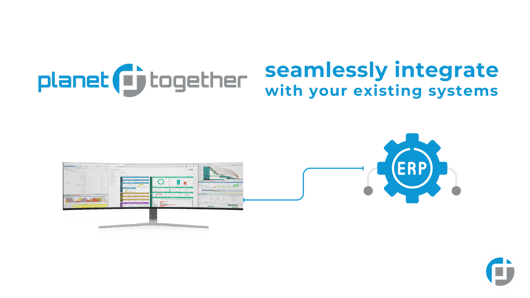
Optimizing the Scheduling Process in Chemical Manufacturing: Harnessing Integration with PlanetTogether APS
Production scheduling in chemical manufacturing is a high-stakes puzzle. With volatile raw materials, stringent safety standards, and batch-dependent processes, even minor inefficiencies can cascade into costly delays or compliance issues. For Production Schedulers, the challenge is to strike the perfect balance between maximizing asset utilization and meeting delivery commitments—all while navigating regulatory constraints and fluctuating customer demands.
Advanced Planning and Scheduling (APS) solutions like PlanetTogether, when integrated with leading ERP systems such as SAP, Oracle, Microsoft Dynamics, Kinaxis, or Aveva, offer a transformative approach to optimizing the scheduling process.
This blog explores how integrated APS tools enable Production Schedulers in chemical manufacturing to make data-driven decisions, reduce operational friction, and unlock new levels of agility and performance.
The Challenges of Scheduling in Chemical Manufacturing
Production Schedulers in chemical facilities face distinct complexities:
Non-linear processes: Chemical reactions can be batch-based or continuous, and often require precise timing and resource allocation.
Resource constraints: Specialized reactors, high-pressure vessels, and lab analysis equipment must be carefully synchronized.
Safety and compliance: Scheduling must factor in hazardous material handling and safety regulations like OSHA and REACH.
Shelf life concerns: Raw materials and intermediates may degrade over time, adding urgency to execution timelines.
Supply chain volatility: Global raw material sourcing is vulnerable to disruptions, requiring quick schedule adjustments.
Without real-time visibility and dynamic planning capabilities, schedulers are forced to make reactive decisions, often relying on spreadsheets or siloed data—leading to inefficiencies and missed opportunities.

APS to the Rescue: What Makes PlanetTogether Stand Out
PlanetTogether APS is purpose-built to address these scheduling challenges. Its features include:
Finite capacity scheduling that considers real-world constraints.
What-if scenario modeling to evaluate alternate production sequences.
Automated schedule optimization to reduce changeovers, minimize downtime, and balance load.
Batch traceability to support compliance and quality assurance.
Multi-site visibility for facilities operating across geographies.
However, these benefits are maximized when PlanetTogether is fully integrated with ERP systems such as SAP, Oracle, Microsoft Dynamics, Kinaxis, or Aveva.

The Power of Integration: A Game Changer for Production Schedulers
When PlanetTogether APS is integrated with your ERP system, the benefits multiply. Here’s how:
Unified Data Environment
ERP systems are typically the source of truth for master data—BOMs, routings, material inventory, and demand forecasts. By connecting PlanetTogether with ERP platforms like SAP or Microsoft Dynamics, schedulers gain instant access to:
Accurate material availability.
Up-to-date customer orders and forecasts.
Real-time inventory status.
Equipment and labor constraints.
This unified data flow eliminates the need for manual data entry, reducing errors and administrative workload.
Real-Time Visibility and Responsiveness
Chemical plants must frequently adapt to changes: a delayed raw material shipment, a sudden spike in demand, or an unexpected equipment failure. Integrated APS allows schedulers to:
Receive real-time alerts from the ERP system.
Instantly simulate rescheduling scenarios.
Reallocate resources dynamically based on capacity or priority.
Communicate changes to stakeholders within minutes.
This agility transforms scheduling from a reactive to a proactive process.
Enhanced Compliance and Traceability
With tight regulations around batch genealogy, lot tracking, and quality audits, integration ensures that compliance data flows seamlessly between production and regulatory systems. Integration with platforms like Aveva or Kinaxis enables:
End-to-end traceability for every batch.
Automatic documentation of production parameters.
Simplified audit trail management.
This not only reduces regulatory risk but also speeds up internal and external reporting.
Greater Forecast Accuracy and Scenario Planning
Forecast volatility is common in chemical production. Integrated APS uses data from ERP and MES platforms to support predictive planning. For instance:
Kinaxis integration enables predictive demand sensing, which feeds accurate forecasts into PlanetTogether.
Oracle’s supply chain planning data allows schedulers to preemptively model different supply/demand scenarios in APS.
The result is better preparedness and reduced reliance on emergency measures like expediting or rework.
Optimized Equipment Utilization
One of the most powerful features of APS integration is the ability to synchronize equipment availability and constraints directly into the scheduling algorithm. For example:
SAP-integrated equipment maintenance schedules automatically update in PlanetTogether, avoiding conflicts.
Microsoft-based plant floor data informs capacity-aware scheduling, reducing idle time.
This leads to better asset utilization, lower energy consumption, and improved throughput.
Implementation Considerations: What Schedulers Need to Know
Successful integration of APS with ERP systems requires collaboration between production scheduling, IT, and operations. Here are some key steps:
Assess scheduling pain points. Identify where delays, inaccuracies, or inefficiencies occur most often.
Align ERP and APS data models. Ensure consistent units of measure, naming conventions, and master data structures.
Start with a pilot line or product. Prove the value in a contained environment before full-scale rollout.
Train schedulers on both systems. Focus on scenario modeling, alert management, and exception handling.
Monitor KPIs. Track improvements in OEE, on-time delivery, and schedule adherence post-implementation.
A Clear Path to Scheduling Excellence
For Production Schedulers in chemical manufacturing, success hinges on the ability to orchestrate complexity with precision. PlanetTogether, when integrated with platforms like SAP, Oracle, Microsoft, Kinaxis, or Aveva, empowers schedulers to make faster, smarter, and safer decisions.
By transforming raw data into actionable intelligence, integrated APS delivers a scheduling process that is not just efficient, but agile, compliant, and future-ready.
Are you ready to take your manufacturing operations to the next level? Contact us today to learn more about how PlanetTogether can help you achieve your goals and drive success in your industry.


